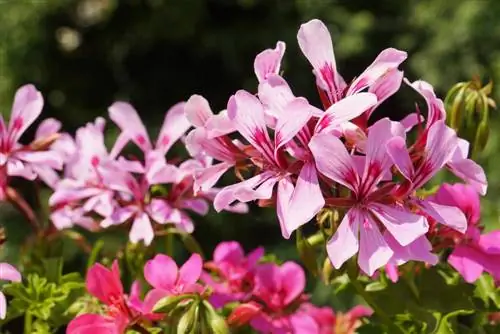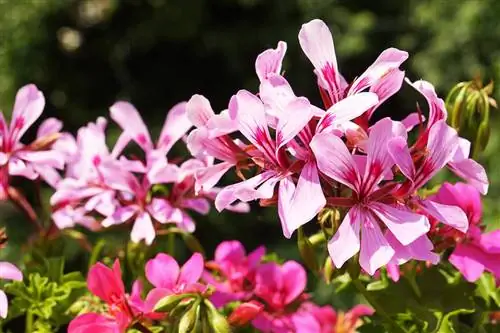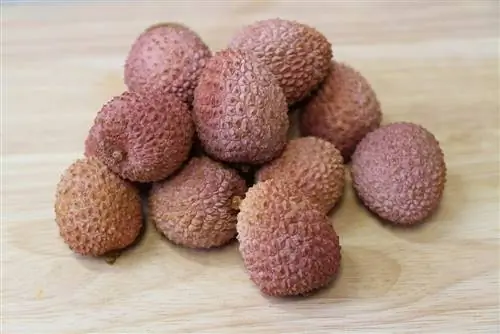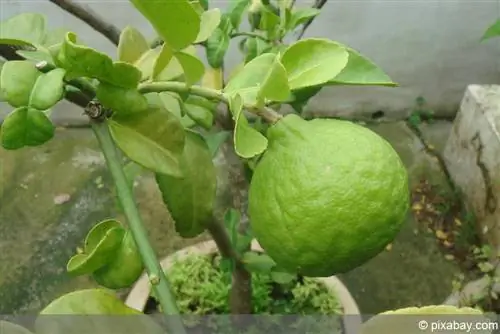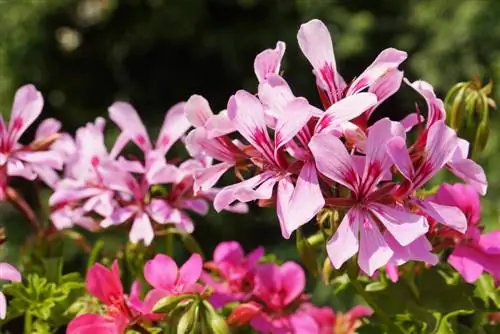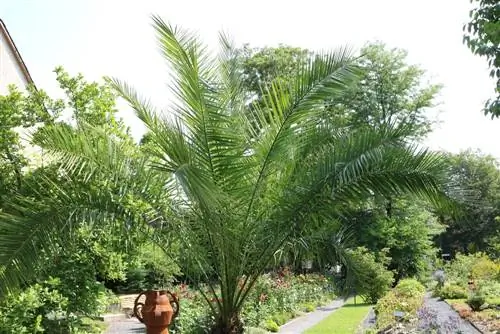- Author admin [email protected].
- Public 2023-12-17 03:39.
- Last modified 2025-06-01 06:48.
Scented pelargoniums are exactly the right plants for the sun-drenched balcony or terrace. Because the decorative and flowering plant loves a place in full sun and requires little care. Scented pelargoniums, which are also known as medicinal plants, are so popular near the seating area in summer, especially because of their intoxicating scent. They are also ideal as potted plants.
Care
The decorative scented pelargoniums exude an intense scent of mint, roses or lemon and are therefore the ideal companion on the terrace or balcony in summer. The plant has a bushy habit with purple or pink flowers. Since the scent of the plant, which originally comes from South Africa, comes from the leaves and not from the flowers, it can also be enjoyed outside of the flowering period. Caring for the unfortunately not winter-hardy plant is quite easy.
Location
Scented pelargoniums especially like it airy, bright and sunny. If they are given a suitable location, they will be rewarded with abundant flowers. Rain and wind are not so good for them. Since the plants are those that have to move in the cold and frost in winter, they are ideally cultivated in a bucket. The right location for the pelargoniums looks like this:
- sunny and sheltered from the wind
- protected from rain under a roof
- covered terrace or balcony ideal
- not suitable for the garden bed
- in winter in a frost-free place
- Basement, frost-free garage, garden house or winter garden
Tip:
Since the scented pelargoniums feel particularly comfortable in summer at temperatures between 18° and 22° degrees, they are also well suited for not so hot climates when the sun often shines here.
Plants
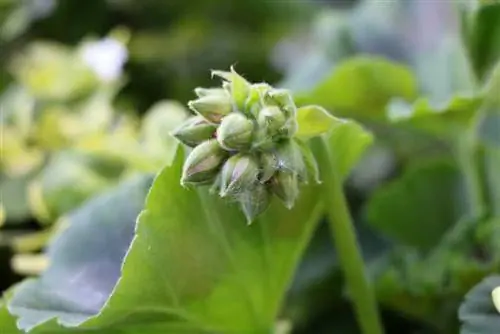
The decorative pelargoniums cannot tolerate any waterlogging. Therefore, the pots or balcony boxes in which the plants are grown must be provided with drainage. To do this, shards of pottery, stones or expanded clay are distributed over the drainage holes in the ground before filling in the soil and planting. Plant fleece is placed over this so that the soil cannot block the drainage. When planting scented pelargoniums, proceed as follows:
- fill the prepared substrate halfway
- Insert plants
- Make sure there is enough distance in boxes
- ideal here is 20 to 30 cm between individual plants
- fill in remaining soil
- press lightly
- pouring
Tip:
Well-stocked garden shops now offer balcony boxes that already have drainage installed.
Substrate & Soil
Normal potting soil for flowering plants from the market is suitable as a substrate. You can also use extra geranium soil, which is also tolerated by the related pelargonium. To ensure that the soil is loose and does not become compacted due to moisture, a portion of sand can be mixed in.
Fertilize
So that the scented pelargonium develops decorative flowers in addition to the scent that is emitted from the leaves, it should be fertilized from April to mid-September. You should proceed as follows:
- Use liquid fertilizer from the market
- there is extra geranium fertilizer
- this one is good for pelargoniums
- never place on dry soil
- then the roots could burn
- Ideal is to add the fertilizer with the irrigation water
Tip:
You should follow the manufacturer's instructions regarding the frequency of fertilizer application. As a rule, the plants should be supplied with fertilizer every two to three weeks, but this can vary from manufacturer to manufacturer.
Pouring
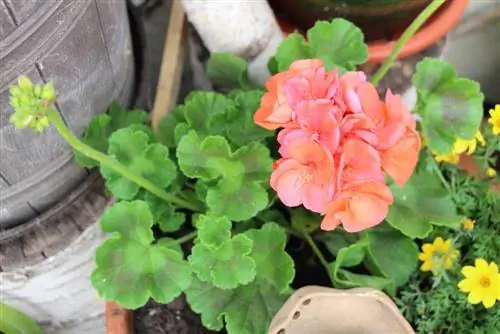
Scented pelargoniums tolerate a little drought better than too much water. Therefore, even on hot days, the plants should only be watered moderately and when it is really necessary. If the soil has dried out on the surface, you can water it moderately. Ideally, rainwater is used for this, but tap water does not harm the geranium as it is not intolerant to lime.
Tip:
Even if the plant has limp leaves due to drought, this is no reason to panic, because with immediate water supply it will recover immediately.
Cutting
Scented pelargoniums only bloom on this year's new shoots. Therefore, the plants must be pruned regularly to ensure abundant flowering. Pruning may also be necessary for overwintering. Therefore, the following should be noted:
- before winter
- Remove buds, shoot tips and flowers
- almost all leaves
- shorten bare stems to 10 - 20 cm
- alternatively cut in spring
- shorten the stems before the first shoots
- remove spent shoots all year round
- stimulates new growth
Tip:
Depending on how the plant is overwintered, it should be cut back in autumn or spring. This will be discussed again in detail in the “Wintering” subsection.
Propagate
The scented pelargoniums can easily be propagated from cuttings, which is usually always successful. For this purpose, shoots with leaves and without flowers are taken from the plant in spring or summer. These can easily be snapped off with your fingers. Then proceed as follows:
- remove all the lower leaves
- the upper leaves can remain on the shoot
- Place stems in a container with water
- alternatively directly into a pot with potting soil
- keep the soil moist here
- If necessary, put transparent foil over it
- bright, warm location
- no direct sunlight
If the pelargoniums are propagated from cuttings early in the year, then small flowers can be expected in the same year. The next spring after the cut, the young plant will already sprout large and will be in full bloom in the summer.
Tip:
If the cuttings taken are first placed in a container with water, it is easier to see when they start to root. If the first roots appear here after a few weeks, the new plants can be potted and moved to the desired location.
Sowing

Scented pelargoniums can also be sown. The seeds for this are commercially available. It should be noted that these are light germinators where the seeds must not be placed far into the soil. These lie on the ground and are only thinly covered. When sowing, proceed as follows:
- Prepare pots with potting soil
- best time for sowing is January
- Laying seeds on soil
- An indoor greenhouse is best
- alternatively put a cut-off PET bottle over it
- optimal germination temperature between 20° and 22° degrees
- Prick out young seedlings
- outdoors in spring after the Ice Saints
- can now go to their final location
- Avoid direct sunlight
Tip:
Before the young plants are moved outdoors in spring, they should slowly get used to the outside temperatures and brightness. From March onwards, they can be taken outside during the day and back inside at night to make it easier to get used to them.
Repotting
Repotting is not necessary for scented pelargoniums that are removed from the pot in winter. If the plants have become larger, simply choose a larger pot for replanting. Plants that have been overwintered in pots must be repotted in spring, whenever roots grow out of the pot. Then a larger container is needed. Otherwise, the pelargonium should be given a fresh substrate every two to three years. When repotting, proceed as described under “Planting”.
Wintering in the dark
Pelargoniums are not hardy and must therefore be protected from frost and cold. Unlike many other plants, the scented pelargoniums are removed from the container. For this you need the autumn pruning in advance. Because during wintering you should proceed as follows:
- remove all leaves, buds and new shoots
- shorten empty shoots to 10 to 20 cm
- Remove the plant from the pot
- remove excess soil
- Put plastic bag around root ball
- Hang naked pelargonium upside down
- in a dark, cool place
- Temperatures between 8° and 10° Celsius
This means that the scented pelargonium does not need to be watered in winter; the plastic film over the root ball prevents the plant from drying out. From February onwards, the plants are awakened from their hibernation, planted in fresh substrate, watered and fertilized regularly from April onwards. The location should be bright but not too warm. Only after the Ice Saints can the plants return to their original summer location.
Wintering in the light

If you want the plant to overwinter brightly, it remains in the pot and is only properly cut back in the spring before the new shoots appear. In such a case, however, it needs regular watering over the winter. When overwintering in the light, you should proceed as follows:
- Put the pelargonium in a pot in a protected location
- an unheated winter garden is ideal
- otherwise a not so warm room
- Stairwell, bedroom or hallway with window
- fertilization is stopped
- Water the plant when necessary
- prune in spring before new growth
- Flowers only form on this year's shoots
- slowly get used to warmer temperatures from March
- Start fertilizing from April
Plants that are overwintered in a pot must also be cut back heavily in spring at the latest, otherwise this will be at the expense of lush flowering.
Care errors, diseases or pests
Since pelargonium in the broader sense belongs to the geranium genus, this decorative plant can also be affected by geranium rust. This can be seen in brown leaves and occurs primarily when the plant has become too wet overall. A change of location and drying of the soil are helpful in such a case. The damaged leaves should be removed. Otherwise, the pelargoniums hardly have to contend with pests; on the contrary, they are often placed close to other plants so that they are not attacked either.
Tip:
Unfortunately, it has recently been noticed more frequently that the horse chestnut leaf miner is spreading more and more and is also settling on the scented pelargoniums. The caterpillars attack the stems from the inside and eat them from the inside. If an infestation is detected, the entire plant must be cut back and placed in fresh substrate. Wasps are natural predators of caterpillars.

